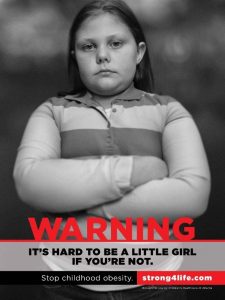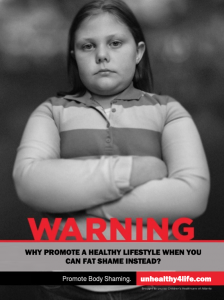Original Advertisement:

Obesity is one of the leading causes of preventable death in the United States. Health data suggests that in 2016, 39.8% of Americans were obese (Centers for Disease Control and Prevention, 2012), and the Government of Canada has reported that 28.2% of Canadian adults and 30% of children between the ages of 5-17 are overweight or obese, and rates have nearly doubled since the 1970s (Government of Canada, 2017). Being one of the leading causes of death, the original advertisement was presented by the Children’s Healthcare of Atlanta to bring awareness to obesity and attempt to prevent obesity rates from growing in America.
Although the advertisement aims to bring awareness to the severity of obesity in America, the message being portrayed to viewers is much more aggressive; the original ad humiliates child obesity and resorts to body shaming tactics in order to get their message across to viewers. Studies have shown that the use of guilt in advertisements is one of the least effective ways for individuals to change their behaviour (Bennett, 1998). Shame and stigma reinforce behaviour that leads to obesity, thus counteracting the original message the advertisement aims to send.
The problematic aspect of the advertisement is the message it portrays to young children – “Warning: it’s hard to be a little girl if you’re not.” The message fat shames children in an attempt to guilt-trip them into losing weight. The ad implies that a child’s youth is compromised because they are overweight, and formulates the message as almost threatening, as it begins with “WARNING”.
Additionally, body shaming young girls can be very harmful to their development, as there is a lot of stigmatization around not having the “perfect, skinny body,” and young girls are exposed to this harmful message on a daily basis. This advertisement ties in this message and disguises itself under obesity-awareness, serving as a unique form of body stigmatization.
A study done by Dixon et al. (2015) found that the obesity prevention campaigns resulted in the strongest cognitive and emotional responses from viewers when ads focused on the negative health outcomes of obesity. Comparing this fact to the original ad, the original ad, rather than educate their viewers, aims to belittle children with obesity, therefore nurturing the stigma surrounding obesity. Children who are overweight are not unaware of the fact, and the advertisement, rather than promoting healthy lifestyle choices, eating habits, and physical activity, uses body shaming to target viewers in hopes to promote a change.
Jammed Advertisement:

The jammed interpretation of this ad aims to target the underlying theme of the original ad: body shaming. I wanted to expose the vileness of the original ad’s message and display the absurdity the original ad showcased to get their message of obesity-awareness across. I went with the phrase “Warning: why promote a healthy lifestyle when you can fat shame instead?” because it exhibits how the original advertisement resorted to guilt and body shaming to illicit an emotional response from its viewers. The jammed advertisement removes the veil of obesity-awareness that the original advertisement hid beneath and exposes the message for what it truly is – guilt-tripping and shame for not being thin, and its failure to portray that obesity is a disease that people suffer from and educating viewers on the consequences that can occur from this disease.
Under the main message, I changed “stop childhood obesity” to “promote body shaming” because the original ad’s message did not promote child obesity prevention effectively; the jammed advertisement focuses on how the original ad took a photo of an overweight child and implied that she was no longer a little girl because she was overweight. The original advertisement implied that the child’s youth was taken away because she suffered from a disease yet did nothing to educate viewers on how obesity can be prevented or counteracted.
The original advertisement also provided a link, “strong4life.com” for more information on obesity-awareness. In the jammed advertisement, I changed this link to “unhealthy4life.com” because as studies by Dixon et al. (2015) and Bennett (1998) have shown, guilt and shame reinforce the same behaviours that originally lead to obesity and is an inappropriate method of action for advertisements concerning obesity prevention. Based on the literature, the original advertisement is doing the complete opposite it is intending to and causing children to engage in behaviour, such as stress eating, thus preventing them from ever overcoming obesity, hence why the “unhealthy4life.com” link was appropriate. This would never allow for children who watch these advertisements to take proactive steps to live a healthy lifestyle and overall sends a message that improperly targets children’s emotions rather than motivating them to make a difference in their health.
References:
Bennett, R. (1998). Shame, guilt & responses to non-profit & public sector ads. International Journal of Advertising, 17(4), 483-499.
Centers for Disease Control and Prevention. (2012). Adult obesity facts. https://www.cdc.gov/obesity/data/adult.html
Dixon, H., Scully, M., Durkin, S., Brennan, E., Cotter, T., Maloney, S., … & Wakefield, M. (2015). Finding the keys to successful adult-targeted advertisements on obesity prevention: an experimental audience testing study. BMC Public Health, 15(1), 804.
Government of Canada. (2017). Obesity in Canadian Adults: It’s About More Than Just Weight. https://health-infobase.canada.ca/datalab/adult-obesity-blog.html
